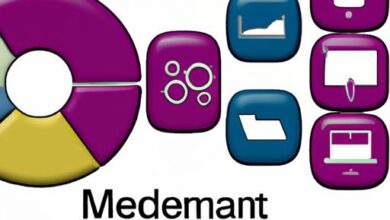Asset Management Tools List: Streamlining Your Business Efficiency

In today’s fast-paced business landscape, managing assets efficiently is crucial for organizations of all sizes. But how can you ensure that your assets are effectively tracked, organized, and utilized? This is where asset management tools come into play. In this article, we will explore the world of asset management tools and their significant impact on businesses.
Introduction
Before we delve into the intricacies of asset management tools, let’s first understand what they are. Asset management tools are software solutions designed to help businesses track, monitor, and optimize their assets throughout their lifecycle. These assets can range from tangible items like machinery, equipment, and vehicles, to intangible assets such as software licenses and intellectual property.
Importance of using asset management tools for businesses
In today’s competitive market, efficient asset management can make or break a company. Here’s why asset management tools are vital for businesses:
-
Enhanced Efficiency: Asset management tools streamline the process of tracking and managing assets, eliminating the need for manual record-keeping and reducing human errors. This automation saves time, boosts productivity, and allows employees to focus on more critical tasks.
-
Optimized Resource Allocation: By providing real-time data on asset utilization, maintenance schedules, and performance metrics, asset management tools enable businesses to make informed decisions regarding resource allocation. This ensures that assets are utilized to their full potential, maximizing returns on investment.
-
Improved Regulatory Compliance: Asset management tools facilitate compliance with industry regulations and standards by maintaining accurate records and documentation. This not only mitigates legal risks but also helps businesses avoid costly penalties and reputational damage.
-
Cost Savings: Efficient asset management leads to cost savings in various ways. By identifying underutilized assets, businesses can eliminate unnecessary expenses on maintenance or purchase of additional assets. Moreover, streamlined processes reduce operational costs and enhance overall financial performance.
In the upcoming sections, we will explore the top asset management tools available in the market, factors to consider when choosing the right tool for your business, and real-life case studies showcasing successful implementation. So, let’s dive deeper into the world of asset management tools and unlock the potential for organizational growth and success.
Benefits of Asset Management Tools
Incorporating asset management tools into your business operations brings a plethora of benefits that can revolutionize the way you manage and utilize your assets. Let’s explore some of these advantages in detail:
Increased Efficiency in Managing Assets
Asset management tools streamline and automate asset tracking processes, eliminating the need for manual record-keeping and reducing the chances of errors. With these tools, you can easily monitor the location, condition, and maintenance schedules of your assets. This efficient management ensures that assets are utilized optimally, reducing downtime and improving overall operational efficiency.
Improved Tracking and Organization of Assets
Gone are the days of relying on spreadsheets or outdated systems to track your assets. Asset management tools provide centralized databases where you can record and access vital information about each asset. This includes details such as purchase history, maintenance logs, depreciation values, and even warranty information. Easy access to accurate and up-to-date data enables you to make informed decisions regarding asset allocation, maintenance, and disposal.
Enhanced Decision-Making through Data-Driven Insights
Asset management tools offer robust reporting and analytics capabilities that transform raw data into actionable insights. By analyzing asset performance, utilization patterns, and maintenance data, you can identify trends, forecast future needs, and make data-driven decisions. This empowers you to optimize asset usage, identify cost-saving opportunities, and align asset strategies with your business goals.
Top Asset Management Tools in the Market
Now that we understand the benefits of asset management tools, let’s explore some of the top tools available in the market. These tools offer a wide range of features and functionalities to cater to diverse business needs. Here are five notable asset management tools:
Tool 1: Description, Features, and Benefits
Tool 1 is a comprehensive asset management solution designed for businesses of all sizes. It offers a user-friendly interface, allowing you to easily track and manage assets across multiple locations. With features like barcode scanning, asset tagging, and automated alerts, this tool streamlines asset tracking and reduces manual effort. Additionally, it provides insightful reports and analytics to optimize asset utilization and minimize costs.
Tool 2: Description, Features, and Benefits
Tool 2 is a cloud-based asset management platform that offers real-time asset tracking and management. Its intuitive dashboard allows you to monitor asset locations, maintenance schedules, and even employee assignments. With features like mobile accessibility, asset history tracking, and customizable workflows, Tool 2 empowers businesses to streamline asset management processes and improve operational efficiency.
Tool 3: Description, Features, and Benefits
Tool 3 is a robust asset management software tailored for industries with complex asset requirements. It offers advanced features such as predictive maintenance, asset lifecycle management, and integration with IoT devices. Tool 3 helps businesses optimize asset performance, reduce downtime, and ensure regulatory compliance. Its comprehensive reporting capabilities provide actionable insights for informed decision-making.
Tool 4: Description, Features, and Benefits
Tool 4 is a scalable asset management solution suitable for businesses with growing asset portfolios. It offers features like asset categorization, customizable fields, and document management. Tool 4 simplifies asset tracking and organization, enabling businesses to efficiently manage assets across different departments or locations. Its intuitive interface and robust search functionality make asset retrieval quick and hassle-free.
Tool 5: Description, Features, and Benefits
Tool 5 is a user-friendly asset management tool designed for small businesses and startups. It provides essential features like asset tracking, maintenance scheduling, and reporting. Tool 5 offers a cost-effective solution for businesses seeking to streamline asset management without complex functionalities. Its simplicity and affordability make it an ideal choice for organizations with limited asset management needs.
By exploring these top asset management tools, you can find the one that aligns with your business requirements and unlocks the full potential of efficient asset management.
Factors to Consider When Choosing Asset Management Tools
When selecting the right asset management tool for your business, several key factors should be taken into consideration. Let’s explore these factors to ensure you make an informed decision:
1. Scalability and Flexibility
Consider the scalability and flexibility of the asset management tool. As your business grows, you need a tool that can accommodate the increasing number of assets and adapt to evolving requirements. Look for a solution that offers scalability, allowing you to expand the tool’s capabilities as your business expands.
2. Integration with Existing Systems
Ensure that the asset management tool seamlessly integrates with your existing systems, such as enterprise resource planning (ERP) software, financial systems, or maintenance management systems. Integration eliminates data silos and enables smooth information flow across different platforms, providing a holistic view of your assets.
3. User-Friendly Interface
A user-friendly interface is crucial for the successful adoption and usage of an asset management tool. Look for a tool that offers an intuitive and easy-to-navigate interface. This ensures that your employees can quickly learn and utilize the tool without extensive training, maximizing efficiency and productivity.
4. Security and Data Protection Measures
The security of your asset data should be a top priority. Ensure that the asset management tool offers robust security measures, such as data encryption, user access controls, and regular backups. Additionally, check if the tool complies with industry regulations, such as GDPR or HIPAA, to safeguard sensitive information.
5. Customer Support and Training Options
Consider the level of customer support and training options provided by the asset management tool provider. Reliable customer support ensures that any issues or concerns are addressed promptly. Training options, such as user manuals, video tutorials, or on-site training, can help your employees effectively utilize the tool’s features and capabilities.
By carefully evaluating these factors, you can choose an asset management tool that aligns with your business requirements, enhances operational efficiency, and positively impacts your bottom line. Let’s move on to the next section, where we’ll explore real-life case studies showcasing successful implementation of asset management tools.
Case Studies: Successful Implementation of Asset Management Tools
In this section, we will explore real-life case studies that demonstrate the successful implementation of asset management tools in different organizations. These examples highlight how businesses have effectively utilized these tools to enhance their asset management processes and drive growth.
Case Study 1: Company A’s experience with Tool X
Company A, a manufacturing firm, faced numerous challenges in managing their extensive range of machinery and equipment. They decided to implement Tool X, an advanced asset management solution. The results were remarkable. Tool X allowed Company A to efficiently track and organize their assets, leading to increased productivity and reduced downtime. The tool’s real-time monitoring capabilities enabled proactive maintenance, ensuring optimal performance and minimizing costly breakdowns. The data-driven insights provided by Tool X also facilitated informed decision-making, enabling Company A to allocate resources effectively and identify areas for improvement. Overall, Tool X revolutionized their asset management practices, resulting in improved operational efficiency and substantial cost savings.
Case Study 2: Company B’s experience with Tool Y
Company B, a global IT services provider, struggled with managing their extensive software licenses and subscriptions. They implemented Tool Y, a comprehensive asset management software designed specifically for software assets. Tool Y provided Company B with a centralized platform to track their licenses, monitor usage, and ensure compliance with licensing agreements. The automated features of Tool Y simplified the license renewal process, eliminating the risk of unauthorized software usage and potential legal issues. With Tool Y, Company B gained valuable insights into software utilization patterns, allowing them to optimize their license allocation and negotiate better deals with vendors. As a result, they achieved significant cost savings and enhanced their software asset management practices.
These case studies exemplify the effectiveness of asset management tools in diverse industries. By leveraging the power of these tools, businesses can streamline their asset management processes, improve decision-making, and achieve remarkable outcomes. Now, let’s move on to the concluding section of this article and summarize the importance of asset management tools for businesses.
Conclusion
In conclusion, asset management tools have become indispensable for businesses seeking efficient and streamlined operations. These tools offer numerous benefits, including increased efficiency in managing assets, improved tracking and organization, and enhanced decision-making through data-driven insights.
By implementing asset management tools, businesses can optimize resource allocation, minimize costs, and ensure regulatory compliance. The ability to make informed decisions based on real-time data empowers organizations to stay ahead of the competition and drive growth.
When selecting asset management tools, it is crucial to consider factors such as scalability, integration capabilities, user-friendliness, security measures, and customer support options. By choosing the right tool, businesses can tailor their asset management processes to their specific needs and achieve optimal outcomes.
Remember, in today’s dynamic business landscape, effective asset management is not a luxury but a necessity. Embrace the power of asset management tools and unlock the full potential of your assets. Whether you are a small business or a large enterprise, these tools can revolutionize the way you manage, track, and utilize your assets.
Now is the time to take action. Explore the top asset management tools available in the market, analyze their features and benefits, and select the one that aligns with your business goals. Embrace the digital revolution, and watch your business thrive with efficient asset management.
So, why wait? Start your journey towards optimized asset management today and reap the rewards of increased efficiency, improved decision-making, and sustainable growth. Your assets are waiting to be managed effectively – it’s time to seize the opportunity!
Conclusion: So above is the Asset Management Tools List: Streamlining Your Business Efficiency article. Hopefully with this article you can help you in life, always follow and read our good articles on the website: investing.dulich3mien.vn


